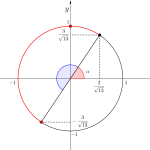こんにちは、リンス(@Lins016)です。
今回は三角関数の積分について学習していこう。
三角関数の積分
三角関数の積分も公式だけじゃなく、角が\(\small{ \ 2x, \ 3x \ }\)の積分や積和の公式を利用して積を和の形にしてからの積分とか色々あるよね。
どの形が試験に出ても解けるようにしておかないといけないよ。
・積分の公式
\(\small{ \ \displaystyle\int \ \sin x \ dx=-\cos x+C \ }\)
\(\small{ \ \displaystyle\int \ \cos x \ dx=\sin x+C \ }\)
\(\small{ \ \displaystyle\int \ \tan x \ dx=-\log |\cos x|+C \ }\)
\(\small{ \ \displaystyle\int \ \displaystyle\frac{1}{\sin^2x } \ dx=-\displaystyle\frac{1}{\tan x}+C \ }\)
\(\small{ \ \displaystyle\int \ \displaystyle\frac{1}{\cos^2x } \ dx=\tan x+C \ }\)
\(\small{ \ \displaystyle\int \ \sin x\cos x \ dx=\displaystyle\int \ \displaystyle\frac{1}{2}\sin 2x \ dx \ }\)
\(\small{ \ \displaystyle\int \ \sin^2x \ dx=\displaystyle\int \ \displaystyle\frac{1-\cos 2x}{2} \ dx \ }\)
\(\small{ \ \displaystyle\int \ \cos^2x \ dx=\displaystyle\int \ \displaystyle\frac{1+\cos 2x}{2} \ dx \ }\)
\(\small{ \ \displaystyle\int \ \tan^2x \ dx=\displaystyle\int \ \left(\displaystyle\frac{1}{\cos^2x }-1\right) \ dx \ }\)
\(\small{ \ \displaystyle\int \ \sin^3x \ dx=\displaystyle\int \ \displaystyle\frac{1}{4}\left(3\sin x-\sin 3x\right) \ dx \ }\)
\(\small{ \ \displaystyle\int \ \cos^3x \ dx=\displaystyle\int \ \displaystyle\frac{1}{4}\left(3\cos x+\cos 3x\right) \ dx \ }\)
三角関数の基本の積分
積分の公式は確実におさえておかないといけないよ。
三角関数の積分
\(\small{ \ \displaystyle\int \ \sin x \ dx=-\cos x+C \ }\)
\(\small{ \ \displaystyle\int \ \cos x \ dx=\sin x+C \ }\)
\(\small{ \ \displaystyle\int \ \tan x \ dx=-\log |\cos x|+C \ }\)
\(\small{ \ \displaystyle\int \ \displaystyle\frac{1}{\sin^2x } \ dx=-\displaystyle\frac{1}{\tan x}+C \ }\)
\(\small{ \ \displaystyle\int \ \displaystyle\frac{1}{\cos^2x } \ dx=\tan x+C \ }\)
\(\small{ \ \sin x, \ \cos x \ }\)の積分は公式だから覚えてないとダメ。
\(\small{ \ \tan x \ }\)は\(\small{ \ \displaystyle\frac{-(\cos x)'}{\cos x} \ }\)だから\(\small{ \ \displaystyle\frac{f'(x)}{f(x)} \ }\)の積分になるよね。
\(\small{ \ \tan x \ }\)を微分すると\(\small{ \ \displaystyle\frac{1}{\cos^2x } \ }\)になるから\(\small{ \ \displaystyle\int \ \displaystyle\frac{1}{\cos^2x } \ dx=\tan x+C \ }\)が言えるよね。
\(\small{ \ \displaystyle\frac{1}{\tan x}=\displaystyle\frac{\cos x}{\sin x} \ }\)
これを微分すると
になる。
だから\(\small{ \ \displaystyle\int \ \displaystyle\frac{1}{\sin^2x } \ dx=-\displaystyle\frac{1}{\tan x}+C \ }\)が言えるんだ。
このあたりは全て公式として覚えて、いつでも使えるようにしておこう。
三角関数の2乗の積分
次に三角関数の\(\small{ \ 2 \ }\)乗の積分についてみていこう。
\(\small{ \ \sin^2x \ }\)と\(\small{ \ \cos^2x \ }\)は\(\small{ \ 2 \ }\)倍角の公式を使って\(\small{ \ 1 \ }\)次の形に変形しよう。
2倍角の公式
\(\small{ \ \begin{eqnarray}
\cos 2x
=
\begin{cases}
1-2\sin^2x\\
2\cos^2\theta-1
\end{cases}
\end{eqnarray} \ }\)から\(\small{ \ \begin{eqnarray}
\left\{
\begin{array}{l}
\sin^2x=\displaystyle\frac{1-\cos 2x}{2} \\[3pt]
\cos^2x=\displaystyle\frac{1+\cos 2x}{2}
\end{array}
\right.
\end{eqnarray} \ }\)
だからこれを積分すればいいんだ。
\(\small{\begin{eqnarray} \ \displaystyle\int \ \sin^2x \ dx&=&\displaystyle\int \ \displaystyle\frac{1-\cos 2x}{2} \ dx\\[3pt]
&=&\displaystyle\frac{1}{2}x-\displaystyle\frac{1}{4}\sin 2\theta+C \ \end{eqnarray}}\)
\(\small{\begin{eqnarray} \ \displaystyle\int \ \cos^2x \ dx&=&\displaystyle\int \ \displaystyle\frac{1+\cos 2x}{2} \ dx\\[3pt]
&=&\displaystyle\frac{1}{2}x+\displaystyle\frac{1}{4}\sin 2\theta+C \ \end{eqnarray}}\)
\(\small{ \ \sin^2x \ }\)と\(\small{ \ \cos^2x \ }\)は\(\small{ \ 2 \ }\)倍角の公式を使って\(\small{ \ 1 \ }\)次にしてから積分しよう。

-

三角関数の最大最小(合成の利用)
。基本的な合成や二倍角の合成について詳しく解説しています。
続きを見る
\(\small{ \ \tan^2x \ }\)の積分は公式というより式変形して考えることになる。
\(\small{\begin{eqnarray}&&\displaystyle\int \ \tan^2x \ dx\\[3pt]
&=&\displaystyle\int \ \displaystyle\frac{\sin^2 x }{\cos^2 x } \ dx\\[3pt]
&=&\displaystyle\int \ \displaystyle\frac{1-\cos^2x }{\cos^2x } \ dx\\[3pt]
&=&\displaystyle\int\left(\displaystyle\frac{1}{\cos^2x }-1\right)dx\\[3pt]
&=&\tan x-x+C \ \end{eqnarray}}\)
この式変形を利用したら\(\small{ \ \displaystyle\int \ \displaystyle\frac{1}{\tan^2x } \ dx \ }\)の積分もできるからやってみよう。
三角関数の3乗の積分
次は三角関数の\(\small{ \ 3 \ }\)乗の積分について考えてみよう。
\(\small{ \ \sin^3x \ }\)と\(\small{ \ \cos^3x \ }\)の積分は\(\small{ \ 2 \ }\)つのやり方があるんだけど、まずは\(\small{ \ 3 \ }\)倍角の公式を使った方法を見てみよう。
3倍角の公式
\(\small{ \ \sin3x=3\sin x-4\sin^3x \ }\)
\(\small{ \ \cos3x=4\cos^3x-3\cos x \ }\)
これを利用すると
\(\small{\begin{eqnarray}&&\displaystyle\int \ \sin^3x \ dx \\[3pt]
&=&\displaystyle\int\left(\displaystyle\frac{3\sin x-\sin3x }{4}\right)dx\\[3pt]
&=&-\displaystyle\frac{3}{4}\cos x+\displaystyle\frac{1}{12}\cos 3x+C \ \end{eqnarray}}\)
同様に
\(\small{\begin{eqnarray}&&\displaystyle\int \ \cos^3x \ dx\\[3pt]
&=&\displaystyle\int\left(\displaystyle\frac{3\cos x+\cos3x }{4}\right)dx\\[3pt]
&=&\displaystyle\frac{3}{4}\sin x+\displaystyle\frac{1}{12}\sin 3x+C \ dx \ \end{eqnarray}}\)
それじゃ次は置換積分で考えてみよう。
\(\small{\begin{eqnarray}&&\displaystyle\int \ \sin^3x \ dx \\[3pt]
&=&\displaystyle\int \ \sin^2x\cdot\sin x \ dx\\[3pt]
&=&\displaystyle\int \ (1-\cos^2x )\sin x \ dx \ \end{eqnarray}}\)
\(\small{ \ t=\cos x \ }\)とおくと
\(\small{ \ \displaystyle\frac{dt}{dx}=-\sin x \ }\)より
\(\small{\begin{eqnarray}&&\displaystyle\int \ (1-\cos^2x )\sin x \ dx\\[3pt]
&=&\displaystyle\int \ (1-t^2) \ (-dt)\\[3pt]
&=&\displaystyle\frac{1}{3}t^3-t+C\\[3pt]
&=&\displaystyle\frac{1}{3}\cos^3x-\cos x+C \ \end{eqnarray}}\)
同様に
\(\small{\begin{eqnarray}&&\displaystyle\int \ \cos^3x \ dx \\[3pt]
&=&\displaystyle\int \ \cos^2x\cdot\cos x \ dx\\[3pt]
&=&\displaystyle\int \ (1-\sin^2x )\cos x \ dx \ \end{eqnarray}}\)
\(\small{ \ t=\sin x \ }\)とおくと
\(\small{ \ \displaystyle\frac{dt}{dx}=\cos x \ }\)より
\(\small{\begin{eqnarray}&&\displaystyle\int \ (1-\sin^2x )\cos x \ dx\\[3pt]
&=&\displaystyle\int \ (1-t^2) \ dt\\[3pt]
&=&t-\displaystyle\frac{1}{3}t^3+C\\[3pt]
&=&\sin x-\displaystyle\frac{1}{3}\sin^3x+C \ \end{eqnarray}}\)
三角関数の置換積分は「奇数乗じゃない方を\(\small{ \ t \ }\)とおく」だったよね。

で同じ答えになるからね。もちろん\(\small{ \ \displaystyle\int \ \cos^3x \ dx \ }\)も同じだよ。
次に\(\small{ \ \tan^3x \ }\)を見ていこう。\(\small{ \ \tan^3x \ }\)はちょっと工夫が必要なんだ。
\(\small{\begin{eqnarray}&&\displaystyle\int \ \tan^3x \ dx \\[3pt]
&=&\displaystyle\int \ \tan^2x\cdot\tan x \ dx\\[3pt]
&=&\displaystyle\int\left(\displaystyle\frac{1}{\cos^2x }-1\right)\tan x \ dx\\[3pt]
&=&\displaystyle\int \ \tan x\cdot\displaystyle\frac{1}{\cos^2x} \ dx-\displaystyle\int \ \tan x \ dx \ \end{eqnarray}}\)
\(\small{ \ \displaystyle\int \ \tan x \ dx=-\log|\cos x|+C \ }\)だから、前の部分の\(\small{ \ \displaystyle\int \ \tan x\cdot\displaystyle\frac{1}{\cos^2x } \ dx \ }\)を考えればいいよね。
\(\small{ \ (\tan x)'=\displaystyle\frac{1}{\cos^2x } \ }\)
だから置換積分を使えば
\(\small{ \ \displaystyle\int \ \tan x\cdot\displaystyle\frac{1}{\cos^2x } \ dx \ }\)
\(\small{ \ t=\tan x \ }\)とおくと\(\small{ \ \displaystyle\frac{dt}{dx}=\displaystyle\frac{1}{\cos^2x} \ }\)より
\(\small{\begin{eqnarray}&&\displaystyle\int \ \tan x\cdot\displaystyle\frac{1}{\cos^2x } \ dx\\[3pt]
&=&\displaystyle\int \ t \ dt\\[3pt]
&=&\displaystyle\frac{1}{2}t^2+C\\[3pt]
&=&\displaystyle\frac{1}{2}\tan^2x+C \ \end{eqnarray}}\)
だから\(\small{ \ \displaystyle\int \ \tan^3x \ dx=\displaystyle\frac{1}{2}\tan^2x-\log|\cos x|+C \ }\)になるんだ。
sinxとcosxの積
置換積分の記事でも書いたけど、\(\small{ \ \displaystyle\int \ \sin^mx\cos^nx \ dx \ }\)は「奇数乗じゃない方を\(\small{ \ t \ }\)とおく」だったよね。
-

覚えておきたい置換積分とその解き方
有名な置換積分法の解き方と注意点について詳しく解説しています。
続きを見る
\(\small{ \ \displaystyle\int \ \sin x\cos x \ dx \ }\)は\(\small{ \ t=\sin x \ }\)とすると\(\small{ \ \displaystyle\frac{dt}{dx}=\cos x \ }\)だから
\(\small{\begin{eqnarray} \ \displaystyle\int \ t \ dt&=&\displaystyle\frac{1}{2}t^2+C\\
&=&\displaystyle\frac{1}{2}\sin^2x+C \ \end{eqnarray}}\)
だけど\(\small{ \ \sin x\cos x=\displaystyle\frac{1}{2}\sin 2x \ }\)とも書けるから、普通はこっちで解くけどね。
\(\small{ \ \displaystyle\int \ \sin ^3\cos ^2x \ dx \ }\)とかなら奇数乗じゃない方(この場合は\(\small{ \ \cos x \ }\))を\(\small{ \ t \ }\)とおこう。
積和の公式の利用
\(\small{ \ \sin x \ }\)と\(\small{ \ \cos x \ }\)の積の形は置換積分だったけど、\(\small{ \ \sin mx \ }\)と\(\small{ \ \cos nx \ }\)のように角が違う積の場合、積和の公式を利用しよう。
積和の公式
\(\small{ \ \sin \alpha\cos \beta=\displaystyle\frac{1}{2}\left\{\sin (\alpha+\beta)+\sin(\alpha-\beta) \right\} \ }\)
\(\small{ \ \cos \alpha\sin \beta=\displaystyle\frac{1}{2}\left\{\sin (\alpha+\beta)-\sin(\alpha-\beta) \right\} \ }\)
\(\small{ \ \cos \alpha\cos \beta=\displaystyle\frac{1}{2}\left\{\cos(\alpha+\beta)+\cos(\alpha-\beta) \right\} \ }\)
\(\small{ \ \sin \alpha\sin \beta=-\displaystyle\frac{1}{2}\left\{\cos (\alpha+\beta)-\cos(\alpha-\beta) \right\} \ }\)
例えば\(\small{ \ \displaystyle\int \ \sin 3x\cos x \ dx \ }\)は\(\small{ \ \sin 3x\cos x=\displaystyle\frac{1}{2}\left(\sin4x+\sin2x\right) \ }\)から
\(\small{\begin{eqnarray}&&\displaystyle\int \ \sin 3x\cos x \ dx\\[3pt]
&=&\displaystyle\int \ \displaystyle\frac{1}{2}\left(\sin4x+\sin2x\right) \ dx\\[3pt]
&=&-\displaystyle\frac{1}{8}\cos 4x-\displaystyle\frac{1}{4}\cos2x+C \ \end{eqnarray}}\)
になる。
角が異なる正弦・余弦の積の積分は和積の公式を利用してから積分しよう。

\(\small{ \ \sin2x\cos4x=\displaystyle\frac{1}{2}\left\{\sin6x+\sin(-2x)\right\} \ }\)
\(\small{ \ \cos4x\sin2x=\displaystyle\frac{1}{2}\left\{\sin6x-\sin2x\right\} \ }\)
\(\small{ \ \sin(-2x)=-\sin2x \ }\)だから同じ値だけど、\(\small{ \ \cos(-2x)=\cos2x \ }\)だから頭で一度符号を考えないといけないよね。だからマイナスが出てこないように、角が大きい方を前に持ってこよう。
次の不定積分を求めよ。
(1)\(\small{ \ \displaystyle\int \ \displaystyle\frac{1}{\sin x} \ dx \ }\)
(2)\(\small{ \ \displaystyle\int \ \sin^4 x \ dx \ }\)
(3)\(\small{ \ \displaystyle\int \ \tan^4x \ dx \ }\)
(4)\(\small{ \ \displaystyle\int \ \displaystyle\frac{1}{\cos^3x } \ dx \ }\)
(5)\(\small{ \ \displaystyle\int \sin mx\cos nx \ dx \ }\)
(1)
\(\small{\begin{eqnarray}&&\displaystyle\int \ \displaystyle\frac{1}{\sin x} \ dx\\[3pt]
&=&\displaystyle\int \ \displaystyle\frac{\sin x}{\sin^2x } \ dx\\[3pt]
&=&\displaystyle\int \ \displaystyle\frac{\sin x}{1-\cos^2x } \ dx \ \end{eqnarray}}\)
\(\small{ \ t=\cos x \ }\)とおくと\(\small{ \ \displaystyle\frac{dt}{dx}=-\sin x \ }\)
\(\small{\begin{eqnarray}&&\displaystyle\int \ \displaystyle\frac{\sin x}{1-\cos^2x } \ dx\\[3pt]
&=&\displaystyle\int \ \displaystyle\frac{dt}{1-t^2}\\[3pt]
&=&\displaystyle\int \ \displaystyle\frac{1}{2}\left(\displaystyle\frac{1}{1-t}+\displaystyle\frac{1}{1+t}\right) \ dx\\[3pt]
&=&\displaystyle\frac{1}{2}\left(-\log |1-t|+\log |1+t|\right)+C\\[3pt]
&=&\displaystyle\frac{1}{2}\left( \displaystyle\frac{1+\cos x}{1-\cos x}\right)+C \ \end{eqnarray}}\)
(2)
\(\small{\begin{eqnarray}&&\displaystyle\int \ \sin^4 x \ dx\\[3pt]
&=&\displaystyle\int \ \left(\displaystyle\frac{1-\cos2x }{2}\right)^2 \ dx\\[3pt]
&=&\displaystyle\int \ \displaystyle\frac{1}{4}\left(1-2\cos2x+\cos^22x \right) \ dx\\[3pt]
&=&\displaystyle\int \ \displaystyle\frac{1}{4}\left(1-2\cos2x+\displaystyle\frac{1+\cos 4x}{2} \right) \ dx\\[3pt]\\
&=&\displaystyle\frac{1}{4}x-\displaystyle\frac{1}{4}\sin 2x+\displaystyle\frac{1}{8}x+\displaystyle\frac{1}{16}\sin 4x+C \ \end{eqnarray}}\)
(3)
\(\small{\begin{eqnarray}&&\displaystyle\int \ \tan^4x \ dx\\[3pt]
&=&\displaystyle\int \ \tan ^2x\cdot \tan ^2x \ dx\\[3pt]
&=&\displaystyle\int \left( \displaystyle\frac{1}{\cos ^2x}-1\right)\tan ^2x \ dx\\[3pt]
&=&\displaystyle\int \ \tan ^2x \cdot\displaystyle\frac{1}{\cos ^2x} \ dx-\displaystyle\int \ \tan^2x \ dx\\[3pt]
&=&\displaystyle\int \ t^2 \ dt-\displaystyle\int \ \displaystyle\frac{1-\cos^2x }{\cos ^2x} \ dx+C \ (t=\tan x)\\[3pt]
&=&\displaystyle\frac{1}{3}\tan ^3x-\left(\displaystyle\int \ \displaystyle\frac{1}{\cos ^2}-1\right) \ dx+C\\[3pt]
&=&\displaystyle\frac{1}{3}\tan ^3x-\tan x +x+C \ \end{eqnarray}}\)
(4)
\(\small{\begin{eqnarray}&&\displaystyle\int \ \displaystyle\frac{1}{\cos^3x } \ dx\\[3pt]
&=&\displaystyle\int \ \displaystyle\frac{\cos x}{\cos^4x } \ dx\\[3pt]
&=&\displaystyle\int \ \displaystyle\frac{\cos x}{(1-\sin ^2x)^2 } \ dx\\[3pt] \ \end{eqnarray}}\)
\(\small{ \ t=\sin x \ }\)とすると\(\small{ \ \displaystyle\int \ \displaystyle\frac{1}{(1-t^2)^2} \ dt \ }\)
ここで
とすると
これは\(\small{ \ t \ }\)についての恒等式だから右辺を通分して
よって
\(\small{ \ \begin{eqnarray}
\left\{
\begin{array}{l}
-a+b=0\\
-a-b+c+d=0\\
a-b+2c-2d=0\\
a+b+c+d=1\\
\end{array}
\right.
\end{eqnarray}
\ }\)
これを解いて\(\small{ \ a=b=c=d=\displaystyle\frac{1}{4} \ }\)
(5)
(i)\(\small{ \ m\neq n \ }\)のとき
(ii)\(\small{ \ m=n \ }\)のとき
\(\small{\begin{eqnarray}&&\displaystyle\int \sin mx\cos mx \ dx\\[3pt]
&=&\displaystyle\int \displaystyle\frac{1}{2}\sin2mx \ dx\\[3pt]
&=&-\displaystyle\frac{\cos2mx}{4m}+C \ \end{eqnarray}}\)
※\(\small{ \ C \ }\)は全て積分定数

出来なかった人はきちんと復習して解き方をマスターしておこう。
Point 三角関数の積分
①三角関数の形によってどの積分を利用するか考える
②積分の解法は確実にマスターする



